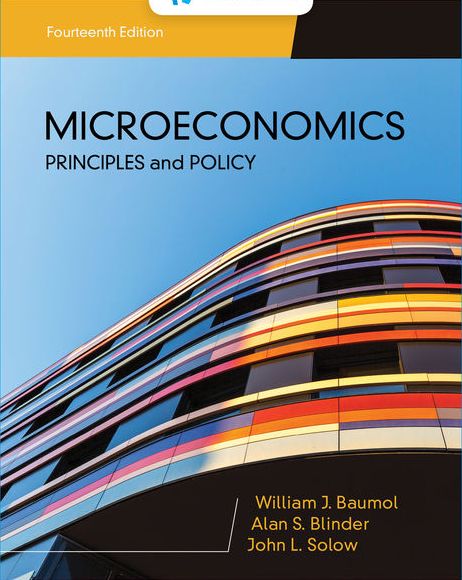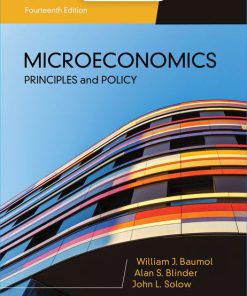Test Bank for Microeconomics: Principles & Policy, 14th Edition, William J. Baumol, Alan S. Blinder, John L. Solow
$35.00 Original price was: $35.00.$26.50Current price is: $26.50.
Test Bank for Microeconomics: Principles & Policy, 14th Edition, William J. Baumol, Alan S. Blinder, John L. Solow,
This is completed downloadable of Test Bank for Microeconomics: Principles & Policy, 14th Edition, William J. Baumol, Alan S. Blinder, John L. Solow

Product Details:
- ISBN-10 : 1337794996
- ISBN-13 : 978-1337794992
- Author: William J. Baumol, Alan S. Blinder, John L. Solow
Master today’s principles of microeconomics and gain an understanding of current economic issues with the solid introduction and policy-based examples and applications found in Baumol/Blinder/Solow’s MICROECONOMICS: PRINCIPLES AND POLICY, 14E. Written by several of today’s most respected economists, this book is one of the most up-to-date microeconomics texts on the market — incorporating data and issues as recent as 2018. The authors combine the right level of rigor and detail to clarify even the most complicated microeconomic concepts. An entirely new chapter closes the book by delving into some of the most important issues confronting the U.S. economy today. Throughout this edition, well-developed examples, intriguing puzzles and meaningful microeconomic issues provide an excellent balance of theory to application while keeping you engaged and intrigued.
Table of Content:
- Part 1: Getting Acquainted with Economics
- Chapter 1: What Is Economics?
- 1-1 Ideas for beyond the Final Exam
- 1-2 Inside the Economist’s Tool Kit
- Summary
- Key Terms
- Discussion Questions
- Appendix: Using Graphs: A Review
- Chapter 2: The Economy: Myth and Reality
- 2-1 The American Economy: A Thumbnail Sketch
- 2-2 The Inputs: Labor and Capital
- 2-3 The Outputs: What Does America Produce?
- 2-4 The Central Role of Business Firms
- 2-5 What’s Missing from the Picture? Government
- 2-6 Conclusion: It’s a Mixed Economy
- Summary
- Key Terms
- Discussion Questions
- Chapter 3: The Fundamental Economic Problem: Scarcity and Choice
- 3-1 Scarcity, Choice, and Opportunity Cost
- 3-2 Scarcity and Choice for a Single Firm
- 3-3 Scarcity and Choice for the Entire Society
- 3-4 The Three Coordination Tasks of Any Economy
- 3-5 The Concept of Efficiency
- 3-6 Task 1. How the Market Fosters Efficient Resource Allocation
- 3-7 Task 2. Market Exchange and Deciding How Much of Each Good to Produce
- 3-8 Task 3. How to Distribute the Economy’s Outputs among Consumers
- 3-9 Looking Ahead
- Summary
- Key Terms
- Test Yourself
- Discussion Questions
- Chapter 4: Supply and Demand: An Initial Look
- 4-1 The Invisible Hand
- 4-2 Demand and Quantity Demanded
- 4-3 Supply and Quantity Supplied
- 4-4 Supply and Demand Equilibrium
- 4-5 Effects of Demand Shifts on Supply-Demand Equilibrium
- 4-6 Supply Shifts and Supply-Demand Equilibrium
- 4-7 Battling the Invisible Hand: The Market Fights Back
- 4-8 A Simple But Powerful Lesson
- Summary
- Key Terms
- Test Yourself
- Discussion Questions
- Part 2: The Building Blocks of Demand and Supply
- Chapter 5: Consumer Choice: Individual and Market Demand
- 5-1 Scarcity and Demand
- 5-2 Utility: A Tool to Analyze Purchase Decisions
- 5-3 Behavioral Economics: Are Economic Decisions Really Made “Rationally”?
- 5-4 Consumer Choice as a Trade-Off: Opportunity Cost
- 5-5 From Individual Demand Curves to Market Demand Curves
- Summary
- Key Terms
- Test Yourself
- Discussion Questions
- Appendix: Analyzing Consumer Choice Graphically: Indifference Curve Analysis
- Chapter 6: Demand and Elasticity
- 6-1 Elasticity: The Measure of Responsiveness
- 6-2 What Determines Price Elasticities of Demand?
- 6-3 Price Elasticity of Demand: Its Effect on Total Revenue and Total Expenditure
- 6-4 Elasticity as a General Concept
- 6-5 The Time Period of the Demand Curve and Economic Decision Making
- 6-6 Real-World Application: AOL’s Flat Rate Internet Pricing
- 6-7 In Conclusion
- Summary
- Key Terms
- Test Yourself
- Discussion Questions
- Appendix: How Can We Find a True Demand Curve from Historical Statistics?
- Chapter 7: Production, Inputs, and Cost: Building Blocks for Supply Analysis
- 7-1 The Economic Short Run versus the Economic Long Run
- 7-2 Production, Input Choice, and Cost with One Variable Input
- 7-3 Multiple Input Decisions: The Choice of Optimal Input Combinations
- 7-4 Cost and Its Dependence on Output
- 7-5 Economies of Scale
- Summary
- Key Terms
- Test Yourself
- Discussion Question
- Appendix: Production Indifference Curves
- Chapter 8: Output, Price, and Profit: The Importance of Marginal Analysis
- 8-1 Price and Quantity: One Decision, Not Two
- 8-2 Total Profit: Keep Your Eye on the Goal
- 8-3 Economic Profit and Optimal Decision Making
- 8-4 Marginal Analysis and Maximization of Total Profit
- 8-5 Generalization: The Logic of Marginal Analysis and Maximization
- 8-6 Conclusion: The Fundamental Role of Marginal Analysis
- 8-7 The Theory and Reality: A Word of Caution
- Summary
- Key Terms
- Test Yourself
- Discussion Question
- Appendix: The Relationships among Total, Average, and Marginal Data
- Chapter 9: The Financial Markets and the Economy: The Tail That Wags the Dog?
- 9-1 Corporations and Their Unique Characteristics
- 9-2 Stock Exchanges and Their Functions
- 9-3 Betting on Securities: Risks to the Entire Economy
- Summary
- Key Terms
- Test Yourself
- Discussion Questions
- Appendix: Buying Stocks and Bonds
- Part 3: The Virtues of the Free Market
- Chapter 10: The Firm and the Industry under Perfect Competition
- 10-1 Perfect Competition Defined
- 10-2 The Perfectly Competitive Firm
- 10-3 The Perfectly Competitive Industry
- 10-4 Perfect Competition and Productive Efficiency
- Summary
- Key Terms
- Test Yourself
- Discussion Questions
- Chapter 11: The Case for Free Markets: The Price System
- 11-1 Efficient Resource Allocation and Pricing
- 11-2 Scarcity and the Need to Coordinate Economic Decisions
- 11-3 How Perfect Competition Achieves Efficiency: A Graphic Analysis
- 11-4 How Perfect Competition Achieves Efficient Output: Marginal Analysis
- 11-5 Toward Assessment of the Price Mechanism
- Summary
- Key Terms
- Test Yourself
- Discussion Questions
- Part 4: The Limitations of Free Markets
- Chapter 12: Monopoly
- 12-1 Monopoly Defined
- 12-2 The Monopolist’s Supply Decision
- 12-3 Can Anything Good Be Said about Monopoly?
- 12-4 Price Discrimination under Monopoly
- 12-5 Monopsony: The Case of a Single Buyer
- Summary
- Key Terms
- Test Yourself
- Discussion Questions
- Chapter 13: Between Competition and Monopoly
- 13-1 Monopolistic Competition
- 13-2 Oligopoly
- 13-3 The Game Theory Approach
- 13-4 Contestable Markets
- 13-5 A Glance Backward: Comparing the Four Market Structures
- 13-6 Monopolistic Competition, Oligopoly, and Public Welfare
- Summary
- Key Terms
- Test Yourself
- Discussion Questions
- Chapter 14: Limiting Market Power: Antitrust and Regulation
- 14-1 The Public Interest Issue: Monopoly Power versus Mere Size
- 14-2 Antitrust Laws and Policies
- 14-3 Anticompetitive Behavior and Antitrust
- 14-4 Concentration
- 14-5 What Is Price Regulation?
- 14-6 The Logic behind Price Regulation
- 14-7 Difficulties with Price Regulation
- 14-8 The Deregulation Experience
- Summary
- Key Terms
- Discussion Questions
- Chapter 15: The Shortcomings of Free Markets
- 15-1 What Does the Market Do Poorly?
- 15-2 Efficient Resource Allocation: A Review
- 15-3 Externalities: Getting the Prices Wrong
- 15-4 Provision of Public Goods
- 15-5 Allocation of Resources between Present and Future
- 15-6 Imperfect Information
- 15-7 Market Failure and Government Failure
- 15-8 The Cost Disease of Personal Services
- 15-9 The Market System on Balance
- 15-10 Epilogue: The Unforgiving Market, Its Gift of Abundance, and Its Dangerous Friends
- Summary
- Key Terms
- Test Yourself
- Discussion Questions
- Chapter 16: Externalities, the Environment, and Natural Resources
- 16-1 The Economics of Environmental Protection
- 16-2 Review-Externalities: A Critical Shortcoming of the Market Mechanism
- 16-3 Basic Approaches to Environmental Policy
- 16-4 Two Cheers for the Market
- 16-5 The Economics of Natural Resources
- 16-6 The Free Market and Pricing of Natural Resources
- 16-7 Exhaustible Resources, Scarcity, and Rising Prices
- 16-8 The Bioeconomics of Renewable Resources
- Summary
- Key Terms
- Test Yourself
- Discussion Questions
- Chapter 17: Taxation and Resource Allocation
- 17-1 Basic Tax Concepts
- 17-2 The Federal Tax System
- 17-3 The State and Local Tax System
- 17-4 The Concept of Equity in Taxation
- 17-5 The Concept of Efficiency in Taxation
- 17-6 Shifting the Tax Burden: Tax Incidence
- 17-7 When Taxation Can Improve Efficiency
- 17-8 Equity, Efficiency, and the Optimal Tax
- Summary
- Key Terms
- Test Yourself
- Discussion Questions
- Appendix: A Graphical Analysis of Excess Burden
- Part 5: The Distribution of Income
- Chapter 18: Pricing the Factors of Production
- 18-1 The Principle of Marginal Productivity
- 18-2 Inputs and Their Derived Demand Curves
- 18-3 Investment, Capital, and Interest
- 18-4 The Determination of Rent
- 18-5 Payments to Business Owners: Are Profits Too High or Too Low?
- 18-6 Criticisms of Marginal Productivity Theory
- Summary
- Key Terms
- Test Yourself
- Discussion Questions
- Appendix: Discounting and Present Value
- Chapter 19: Labor and Entrepreneurship: The Human Inputs
- 19-1 The Markets for Labor
- 19-2 Wage Determination in Competitive Markets
- 19-3 The Supply of Labor
- 19-4 Why Do Wages Differ?
- 19-5 Unions and Collective Bargaining
- 19-6 The Entrepreneur: The Other Human Input
- 19-7 The Market Economy’s Incredible Growth Record
- 19-8 Sources of Free-Market Innovation: The Role of the Entrepreneur
- 19-9 Entrepreneurship and Growth
- 19-10 Institutions and the Supply of Innovative Entrepreneurship
- Summary
- Key Terms
- Test Yourself
- Discussion Questions
- Chapter 20: Poverty, Inequality, and Discrimination
- 20-1 The Facts: Poverty
- 20-2 The Facts: Inequality
- 20-3 Some Reasons for Unequal Incomes
- 20-4 The Facts: Discrimination
- 20-5 The Trade-Off between Equality and Efficiency
- 20-6 Policies to Combat Poverty
- 20-7 Other Policies to Combat Inequality
- 20-8 Policies to Combat Discrimination
- 20-9 A Look Back
- Summary
- Key Terms
- Test Yourself
- Discussion Questions
- Appendix: The Economic Theory of Discrimination
- Part 6: The United States in the World Economy
- Chapter 21: International Trade and Comparative Advantage
- 21-1 Why Trade?
- 21-2 International versus Intranational Trade
- 21-3 The Principle of Comparative Advantage
- 21-4 The Arithmetic of Comparative Advantage
- 21-5 Tariffs, Quotas, and Other Interferences with Trade
- 21-6 Why Inhibit Trade?
- 21-7 Can Cheap Imports Hurt a Country?
- Summary
- Key Terms
- Test Yourself
- Discussion Questions
- Appendix: Demand, and Pricing in World Trade
- Part 7: The Economy Today
- Chapter 22: Contemporary Issues in the U.S. Economy
- 22-1 Will Artificial Intelligence Leave No Work for Humans to Do?
- 22-2 Are Uber and AirBnB the Markets of the Future?
- 22-3 Is The “Gig” Economy the Future of Work?
- 22-4 Is The Student Debt “Crisis” Really a Crisis?
- 22-5 How Will We Pay for Health Insurance?
- Summary
- Key Terms
- Discussion Questions
- Appendix
- Glossary
- Index
People Also Search:
microeconomics principles and policy 14th edition
microeconomics principles and policy
microeconomics principles and policy 14th edition download scribd
microeconomics principles and policy 14th edition test bank download pdf
You may also like…
Solution Manual
Test Bank
Test Bank for Introduction to Criminal Justice, 14th Edition, Larry J. Siegel John L. Worrall
Solution Manual












